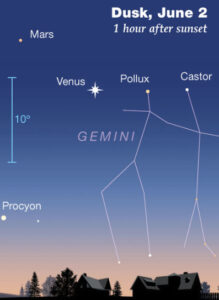Special to CosmicTribune.com, May 31, 2023
SATURDAY, MAY 27
First-quarter Moon (exact at 11:22 a.m. on this date EDT).

Jupiter and Mercury low in the dawn, May 27, 2023 By now Jupiter is getting easier to see low in the eastern dawn. And little Mercury is barely coming into view. Bring binoculars.
SUNDAY, MAY 28
Vega shines in the east-northeast. Arcturus is way up very high toward the south.
Two thirds of the way from Arcturus to Vega is the dim Keystone of Hercules, now lying almost level. Use binoculars or a telescope to examine the Keystone’s top edge. A third of the way from its left end to the right is 6th-magnitude M13, one of Hercules’s two great globular star clusters. In binoculars it’s a tiny glowing cotton ball. A 4- or 6-inch scope begins to resolve some of its speckliness. Located 22,000 light-years away far above the plane of the Milky Way, it consists of several hundred thousand stars in a swarm about 140 light-years wide.
MONDAY, MAY 29
Bright Arcturus shines pale yellow-orange high overhead toward the south these evenings.
TUESDAY, MAY 30
“Cassiopeia” usually means “Cold!” Late fall and winter are when this landmark constellation stands high overhead after dark (seen from mid-northern latitudes). But even on these warm evenings, it still lurks low.
THURSDAY, JUNE 1
Venus lines up with Pollux and Castor on June 1 and 2, while Mars looks on.Don’t miss the Venus-Pollux-Castor lineup at dusk. The lineup is closest to perfect the evening of June 1st (seen at dusk in the longitudes of the Americas).
FRIDAY, JUNE 2
After dark Mars shines inside the Beehive cluster, M44, near the central beehive-shaped asterism itself (which is currently tilted right). Use binocs or, better, a telescope.
SATURDAY, JUNE 3
Full Moon (exact at 11:43 p.m. EDT). Look for orange Antares just 3° or 4° to the Moon’s upper right this evening. Binoculars will help pull Antares out of the bright moonglare.

You must be logged in to post a comment Login